I’ve always been captivated by the timeless appeal of old soul music. From the raw emotion in Otis Redding’s voice to the smooth harmonies of The Temptations there’s something magical about those classic recordings from the 1960s and early ’70s that modern music just can’t replicate. Growing up I discovered my parents’ vinyl collection filled with gems from Motown Stax and Atlantic Records. These weren’t just songs – they were stories of love heartbreak and triumph backed by powerful horn sections thumping bass lines and unforgettable melodies. The authenticity of artists like Aretha Franklin Sam Cooke and Al Green created a musical movement that continues to influence artists today. I’ll take you on a journey through the golden age of soul music exploring the artists venues and recording techniques that made this genre legendary.
- Soul music’s timeless appeal comes from its authentic combination of gospel roots, raw emotions, and distinct musical elements like powerful horn sections, Hammond B3 organ, and walking bass lines.
- The golden era of soul (1960-1975) was dominated by two major labels: Motown Records with its polished urban sound, and Stax Records with its grittier Memphis-style recordings.
- Legendary artists like Aretha Franklin, James Brown, Otis Redding, and The Temptations defined the genre through their distinctive vocal styles and emotional performances.
- Soul music played a crucial role in the Civil Rights Movement, with artists using their platform to promote racial equality and social change through powerful anthems.
- Modern soul and neo-soul artists continue the genre’s legacy by combining vintage recording techniques with contemporary technology, while hip-hop producers frequently sample classic soul recordings.
Old Soul Music
Soul music’s enduring appeal stems from its authentic combination of gospel roots rhythmic patterns raw emotions. These elements create a musical experience that resonates across generations transcending cultural boundaries.
Musical Elements of Classic Soul
Classic soul music incorporates distinct musical components that set it apart from other genres. The prominent basslines anchor the rhythm section creating a solid foundation for intricate horn arrangements syncopated guitar patterns. A standard soul arrangement features:
- Call-response patterns between lead vocalists background singers
- Memphis-style horn sections with punchy brass arrangements
- Hammond B3 organ providing warm harmonic textures
- Syncopated drum patterns emphasizing beats 2 4
- Walking bass lines that groove with the percussion
The recording techniques of legendary studios like Stax Motown captured these elements using:
| Studio Element | Purpose | Impact |
|---|---|---|
| Analog tape | Warm sound saturation | Rich harmonics |
| Live recording | Band chemistry | Natural dynamics |
| Room acoustics | Natural reverb | Spatial depth |
The Raw Emotional Appeal
Soul music’s emotional authenticity manifests through unfiltered expressions of human experience. The vocal performances contain:
- Gritty textures that convey genuine feelings
- Improvisational runs reflecting spiritual roots
- Dynamic range from whispers to powerful crescendos
- Personal storytelling through lyrics about love loss triumph
- Melodic phrases derived from gospel traditions
- Unedited vocal takes preserving natural imperfections
- Live band recordings capturing organic interactions
- Minimal post-production maintaining authenticity
- Strategic microphone placement capturing vocal nuances
- Single-take recordings preserving emotional continuity
The Golden Era of Soul Music
The period between 1960-1975 marked soul music’s definitive golden age, characterized by groundbreaking artistic innovations at two legendary record labels. These powerhouses shaped the genre’s evolution through distinct production techniques distinctive regional sounds.
Motown’s Signature Sound
Motown Records created a polished urban sound in Detroit featuring sophisticated arrangements string sections three-part harmonies. The label’s house band, The Funk Brothers, recorded over 180 number-one hit songs through precise instrumental layering techniques. Notable Motown recordings include:
- Coordinated choreography performances from The Supremes The Temptations The Four Tops
- Prominent tambourine eighth notes combined with four-on-the-floor drum patterns
- Multiple vocal overdubs creating thick harmonies characteristic reverb effects
- Strategic use of vibraphone piano riffs enhancing melodic hooks
- Implementation of call-response patterns between lead backup vocals
Stax Records and Southern Soul
Stax Records developed a grittier Memphis sound characterized by horn-driven arrangements raw emotional delivery. The label’s house band, Booker T. & the M.G.’s, recorded in a converted movie theater using minimal technology equipment. Key elements include:
- Heavy emphasis on Hammond B3 organ Memphis Horns brass section
- Stripped-down production focusing on live single-take recordings
- Integration of gospel-influenced vocal techniques emotional intensity
- Prominent bass guitar lines driving rhythmic groove
- Incorporation of blues-based guitar riffs Memphis rhythm section
| Recording Element | Motown | Stax |
|---|---|---|
| Studio Type | Purpose-built facility | Converted theater |
| Recording Method | Multiple takes layered | Live single takes |
| Sound Character | Polished refined | Raw emotional |
| Primary Instruments | Strings vibraphone | Horns organ |
| Mixing Approach | Complex overdubs | Minimal processing |
Legendary Soul Artists and Their Impact
Soul music’s most influential figures revolutionized the genre through their distinctive vocal styles, emotional performances, and innovative musical arrangements during the 1960s and early 1970s.
The Kings and Queens of Soul
Soul music’s royal court features iconic solo artists who defined the genre’s sound and style:
- Aretha Franklin earned 18 Grammy Awards and the title “”Queen of Soul”” through hits like “”Respect”” and “”Natural Woman””
- James Brown pioneered funk-soul fusion through dynamic stage performances and rhythm-driven hits like “”Papa’s Got a Brand New Bag””
- Otis Redding captured raw emotion in classics like “”(Sittin’ On) The Dock of the Bay”” and “”Try a Little Tenderness””
- Sam Cooke transformed gospel techniques into soul standards with “”A Change Is Gonna Come”” and “”You Send Me””
- Ray Charles blended R&B, gospel and jazz in groundbreaking recordings like “”Georgia On My Mind”” and “”Hit the Road Jack””
- Al Green perfected smooth soul with his falsetto in hits like “”Let’s Stay Together”” and “”Love and Happiness””
- The Temptations pioneered choreographed performances and five-part harmonies in hits like “”My Girl”” and “”Papa Was a Rolling Stone””
- The Four Tops delivered passionate vocals through classics like “”Reach Out I’ll Be There”” and “”Baby I Need Your Loving””
- Sly & The Family Stone integrated psychedelic elements in songs like “”Dance to the Music”” and “”Everyday People””
- The Supremes dominated pop-soul with 12 #1 hits including “”Where Did Our Love Go”” and “”Stop! In the Name of Love””
- The Impressions shaped social consciousness through songs like “”People Get Ready”” and “”Keep On Pushing””
- Martha and the Vandellas energized dance floors with “”Dancing in the Street”” and “”Heat Wave””
| Artist/Group | Number of Top 10 Hits | Grammy Awards | Million-Selling Singles |
|---|---|---|---|
| Aretha Franklin | 17 | 18 | 14 |
| James Brown | 17 | 3 | 11 |
| The Supremes | 20 | 0 | 12 |
| The Temptations | 14 | 4 | 15 |
| Sam Cooke | 16 | 1 | 8 |
Soul Music’s Cultural Significance
Soul music emerged as a powerful cultural force that shaped American society through its profound impact on civil rights, fashion trends, and social movements of the 1960s and 1970s.
Civil Rights Movement Connection
Soul music became the soundtrack of the Civil Rights Movement, amplifying African American voices during pivotal moments of social change. Songs like Sam Cooke’s “”A Change Is Gonna Come”” (1964) and James Brown’s “”Say It Loud – I’m Black and I’m Proud”” (1968) inspired activism while promoting racial equality. Notable performances at civil rights rallies included:
- Organizing benefit concerts at the Apollo Theater to support voter registration drives
- Performing at the March on Washington in 1963 alongside Dr. Martin Luther King Jr.
- Broadcasting empowering messages through Black-owned radio stations
- Creating anthems that unified communities during peaceful protests
- Establishing artist-owned record labels to maintain creative control
Fashion and Style Influence
Soul artists revolutionized fashion through distinctive stage outfits that combined elegance with cultural expression. Key style elements included:
- Motown’s coordinated glamour looks:
- Matching sequined gowns
- Tailored suits with sharp lapels
- Patent leather shoes
- Carefully choreographed movements
- Stax artists’ bold fashion statements:
- African-inspired prints
- Vibrant color combinations
- Platform shoes
- Statement jewelry pieces
- Popular dance moves paired with specific clothing styles
- Signature hairstyles like the conk and the natural afro
- Accessories that became cultural symbols
- Gender-neutral fashion elements
- Custom-designed performance wear
| Fashion Trend | Notable Artist | Year Popularized |
|---|---|---|
| Dashiki | Nina Simone | 1965 |
| Funky jumpsuit | James Brown | 1968 |
| Beehive updo | The Supremes | 1963 |
| Bell-bottoms | The Temptations | 1969 |
Modern Soul Music’s Roots in Classic Soul
Contemporary soul artists draw direct inspiration from classic soul’s foundational elements. Amy Winehouse incorporated the Motown sound in “”Back to Black”” using vintage recording techniques at Mark Ronson’s analog studio. Adele’s powerful vocals in “”Rolling in the Deep”” echo Aretha Franklin’s emotional delivery style.
Neo-Soul Movement
The neo-soul genre emerged in the 1990s as a direct continuation of classic soul traditions. D’Angelo’s “”Brown Sugar”” (1995) utilized classic soul recording techniques:
- Live instrument tracking
- Minimal digital processing
- Extended jam sessions
- Room microphone placement
Production Techniques
Modern soul producers integrate vintage equipment with contemporary technology:
| Classic Equipment | Modern Application | Notable Examples |
|---|---|---|
| Hammond B3 Organ | Digital sampling | Anderson .Paak “”Ventura”” |
| Analog tape | Tape simulation plugins | Leon Bridges “”Coming Home”” |
| Tube amplifiers | Hardware emulation | Michael Kiwanuka “”Love & Hate”” |
Contemporary Soul Artists
Today’s soul musicians maintain classic elements while adding modern touches:
- Leon Bridges recreates 1960s recording environments
- Sharon Jones & The Dap-Kings used period-correct instruments
- Black Pumas blend psychedelic elements with Stax-inspired arrangements
- Durand Jones & The Indications incorporate classic four-part harmonies
Sampling Culture
Hip-hop producers frequently sample classic soul recordings:
- Kanye West sampled Otis Redding in “”Otis””
- J Dilla’s extensive use of soul vinyl records
- 9th Wonder’s incorporation of The Delfonics
- Mark Ronson’s collaboration with classic soul artists
The preservation of analog recording techniques alongside modern production methods creates a bridge between classic soul’s authentic sound and contemporary musical innovations.
Old soul music isn’t just a genre – it’s a timeless art form that continues to move and inspire listeners across generations. I’ve shared my passion for this incredible music and explored its rich history from the iconic recording studios to the legendary artists who shaped it.
The soul music legacy lives on through modern artists who honor its traditions while creating their own path. As I listen to these timeless classics I’m reminded that great music transcends time and speaks directly to the heart. That’s the true magic of soul music and why it’ll always have a special place in music history.



